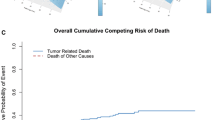Abstract
Limited data are available concerning the outcome of patients with atypical and malignant meningiomas. We therefore analyzed the outcome of seventeen patients with meningiomas (9 atypical; 8 malignant) at Thomas Jefferson University Hospital between 1973 and 1996. Strict adherence to the 1993 WHO criteria for the typing of CNS tumors was maintained.
The median potential follow-up period for all patients was 87 months. The age at diagnosis ranged from 22 to 72 (mean 51.8 years). There were 5 males and 12 females. The mean tumor diameter was 4.45 cm. Of the 16 cases where the extent of surgical resection was known, 4 were partial and 12 were complete resections. Six patients (35%) had dural or cortical invasion by tumor. Fifteen patients received postoperative megavoltage photon irradiation (mean 61 Gy). One of these fifteen pts. received an additional 20 Gy with Au-198 implantation and 1 received post-radiation chemotherapy for recurrent disease.
The overall survival rate for all patients at 5 and 10 years were 87% and 58% respectively. The 5- and 10-year survival rates for atypical meningiomas were 87% and 58%; for malignant meningiomas the survival rates were 60% and 60% respectively. Five patients (30%) have died. Three of these 5 patients initially received less than 54 Gy to the tumor bed and have died of recurrent disease. Local disease progression was documented in 11 patients (65%) after surgery and in 3 patients (18%) after radiation. There was an improvement in performance status in 3 (18%) paients with a decline and no change seen in 1 (6%) and 13 (77%) respectively after receiving radiation. There appeared to be no difference in survival in patients as a function of dural or cortical invasion.
Long term survival is possible for patients with atypical and malignant meningiomas treated with surgery and post-operative radiation. We are unable to distinguish a difference in outcome between these two pathological entities. Dural and cortical invasion were not associated with a decrease in survival. In addition, improved tumor control and survival may be associated with increased radiation dose.
Similar content being viewed by others
References
Maier H, Ofner D, Hittmair A, Dictmar O, Kitz K, Budka H: Classic, atypical and anaplatic meningioma: three histopathological subtypes of clinical relevance. J Neurosurg 77: 616–623, 1992
Mirabell R, Lingood RM, de la Mont S: The role of radiation therapy in the treatment of subtotally resected benign meningiomas. J Neuro-oncol 13: 157–164, 1992
Glaholm J, Bloom HJ, Crow H: The role of radiotherapy in the management of intracranial meningiomas: The Royal Marsden Hospital experience with 186 patients. Int J Radiat Oncol Biol Phys 18: 755–761, 1990
Taylor B, Mareus R, Friedman W, Ballinger W, Million R: The meningioma controversy: postoperative radiation therapy. Int J Radiat Oncol Biol Phys 15: 299–304, 1988
Kleihues P, Burger BC, Scheithauer BA, Sobin LH: Histological typing of tumours of the central nervous system. In: World Health Organization International Classification of Tumours. Springer-Verlag, 1993, pp 33–37
Milosevic MF, Frost PJ, Laperriere NJ, Wong CS, Simpson WJ: Therapy for atypical or malignant intracranial meningioma. Int J Radiat Oncol Biol Phys 34: 817–822, 1996
Thomas H, Clarisse LD, Berry K: Malignant meningioma: clinical and pathological features. J Neurosurg 55: 929–934, 1981
Alvarez F, Roda JM, Blazquez MG: Malignant and atypical meningiomas: a reappraisal of clinical, histological, and computed tomographic features. Neurosurg 20: 688–694, 1987
Hoshino T, Nagashima T, Murovic JA, Wilson C, Davis R. Proliferative potential of human meningiomas of the brain. A cell kinetics study with Bromodeoxyuridine. Cancer 58: 1466–1472, 1986
Chamberlin MC: Adjuvant combined modality therapy for malignant meningiomas. J Neurosurg 84: 733–736, 1996
Goldsmith BJ, Wara WM, Wilsonn B, Larson DA: Postoperative irradiation for subtotally resected meningiomas. A retrospective analysis of 140 patients treated from 1967 to 1990. J Neurosurg 80: 195–201, 1994
Barharo NM, Gutin PH, Wilson CB, Sheline GE, Boldrey EB, Wara WM: Radiation therapy in the treatment of partially resected meningiomas. Neurosurg 20: 525–528, 1987
de Monte F: Current management of meningiomas. Oncol 9: 83–101, 1995
Inoue H, Tamura M, Koizumi H, Nakamura M, Naganuma H, Ohye C: Clinical pathology of malignant meningiomas. Acta Neurochir 73: 179–191, 1984
Devita VT, Hellman S, Rosenberg SA (eds): Cancer, Principles and Practices of Oncology. J.B. Lippincott Co., 1993, pp 1712–1714
Author information
Authors and Affiliations
Rights and permissions
About this article
Cite this article
Coke, C.C., Corn, B.W., Werner-Wasik, M. et al. Atypical and malignant meningiomas: an outcome report of seventeen cases. J Neurooncol 39, 65–70 (1998). https://doi.org/10.1023/A:1005981731739
Issue Date:
DOI: https://doi.org/10.1023/A:1005981731739




